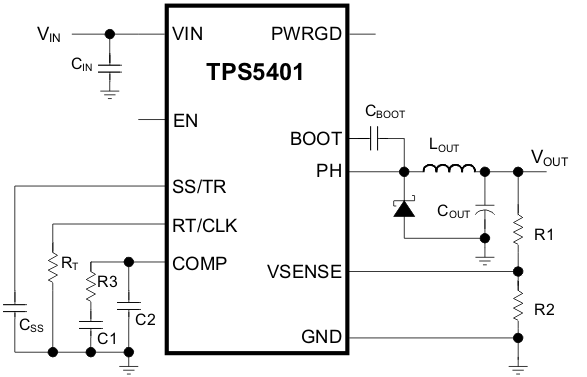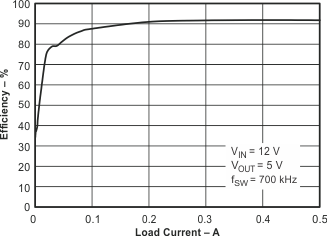SLVSAB0B December 2010 – November 2014 TPS5401
PRODUCTION DATA.
- 1 Features
- 2 Applications
- 3 Description
- 4 Revision History
- 5 Pin Configuration and Functions
- 6 Specifications
-
7 Detailed Description
- 7.1 Overview
- 7.2 Functional Block Diagram
- 7.3
Feature Description
- 7.3.1 Fixed Frequency PWM Control
- 7.3.2 Slope Compensation Output Current
- 7.3.3 Low-Dropout Operation and Bootstrap Voltage (BOOT)
- 7.3.4 Error Amplifier
- 7.3.5 Voltage Reference
- 7.3.6 Adjusting the Output Voltage
- 7.3.7 Enabling and Adjusting Undervoltage Lockout
- 7.3.8 Slow-Start/Tracking Pin (SS/TR)
- 7.3.9 Overload Recovery Circuit
- 7.3.10 Sequencing
- 7.3.11 Constant Switching Frequency and Timing Resistor (RT/CLK Pin)
- 7.3.12 Overcurrent Protection and Frequency Shift
- 7.3.13 Selecting the Switching Frequency
- 7.3.14 How to Interface to RT/CLK Pin
- 7.3.15 Power Good (PWRGD Pin)
- 7.3.16 Overvoltage Transient Protection
- 7.3.17 Thermal Shutdown
- 7.3.18 Current-Mode Compensation Design
- 7.4 Device Functional Modes
-
8 Application and Implementation
- 8.1 Application Information
- 8.2
Typical Application
- 8.2.1 Design Requirements
- 8.2.2
Detailed Design Procedure
- 8.2.2.1 Switching Frequency
- 8.2.2.2 Output Voltage Setpoint
- 8.2.2.3 Input Capacitor
- 8.2.2.4 Output Inductor Selection
- 8.2.2.5 Output Capacitor
- 8.2.2.6 Catch Diode
- 8.2.2.7 Slow-Start Capacitor
- 8.2.2.8 Bootstrap Capacitor Selection
- 8.2.2.9 Undervoltage Lockout Set Point
- 8.2.2.10 Compensation
- 8.2.2.11 Discontinuous Mode and Eco-mode Control-Scheme Boundary
- 8.2.2.12 Power Dissipation Estimate
- 8.2.3 Application Curves
- 9 Power Supply Recommendations
- 10Layout
- 11Device and Documentation Support
- 12Mechanical, Packaging, and Orderable Information
1 Features
- 3.5-V to 42-V Input Voltage Range
- 200-mΩ High-Side MOSFET
- High Efficiency at Light Loads With a Pulse-Skipping Eco-mode™ Control Scheme
- 116-μA Operating Quiescent Current
- 1.3-μA Shutdown Current
- 100-kHz to 2.5-MHz Switching Frequency
- Synchronizes to External Clock
- Adjustable Slow Start/Sequencing
- UV and OV Power-Good Output
- Adjustable UVLO Voltage and Hysteresis
- 0.8-V ±3.5% Internal Voltage Reference
- MSOP10 With PowerPAD™ Package
- Supported by WEBENCH
2 Applications
- 12-V and 24-V Industrial and Commercial Low-Power Systems
- E-Meters
3 Description
The TPS5401 device is a 42-V, 0.5-A, step-down regulator with an integrated high-side MOSFET. Current-mode control provides simple external compensation and flexible component selection. A low-ripple pulse-skip mode reduces the supply current to 116 μA when outputting regulated voltage with no load. Using the enable pin, shutdown supply current is reduced to 1.3 μA when the enable pin is low.
Undervoltage lockout is internally set at 2.5 V, but can be increased using the enable pin. The output voltage start-up ramp is controlled by the slow-start pin that can also be configured for sequencing/tracking. An open-drain power-good signal indicates the output is within 94% to 107% of its nominal voltage.
A wide switching-frequency range allows efficiency and external component size optimization. Frequency foldback and thermal shutdown protect the part during an overload condition.
The TPS5401 is available in a 10-pin thermally enhanced MSOP PowerPAD package.
Device Information(1)
| PART NUMBER | PACKAGE | BODY SIZE (NOM) |
|---|---|---|
| TPS5401 | MSOP (10) | 3.00 mm × 3.00 mm |
- For all available packages, see the orderable addendum at the end of the datasheet.
Simplified Schematic

Efficiency vs. Load Current
